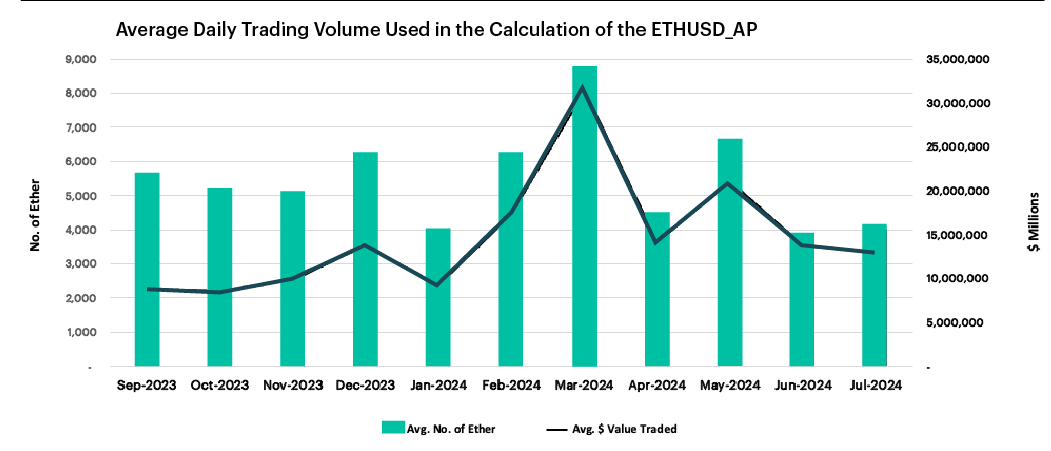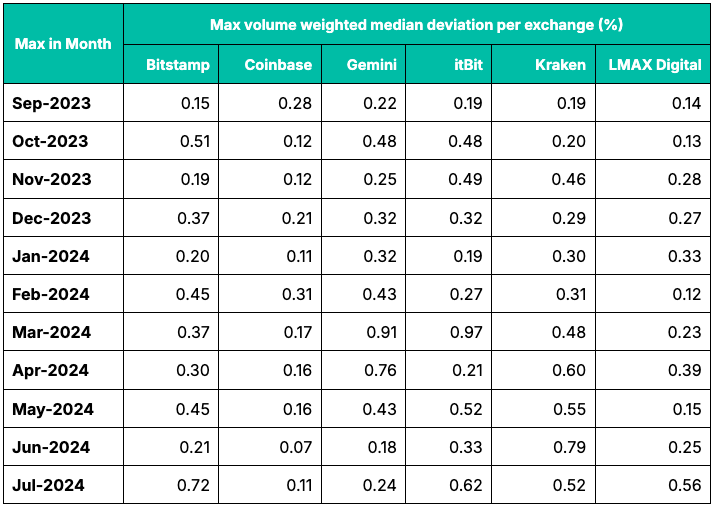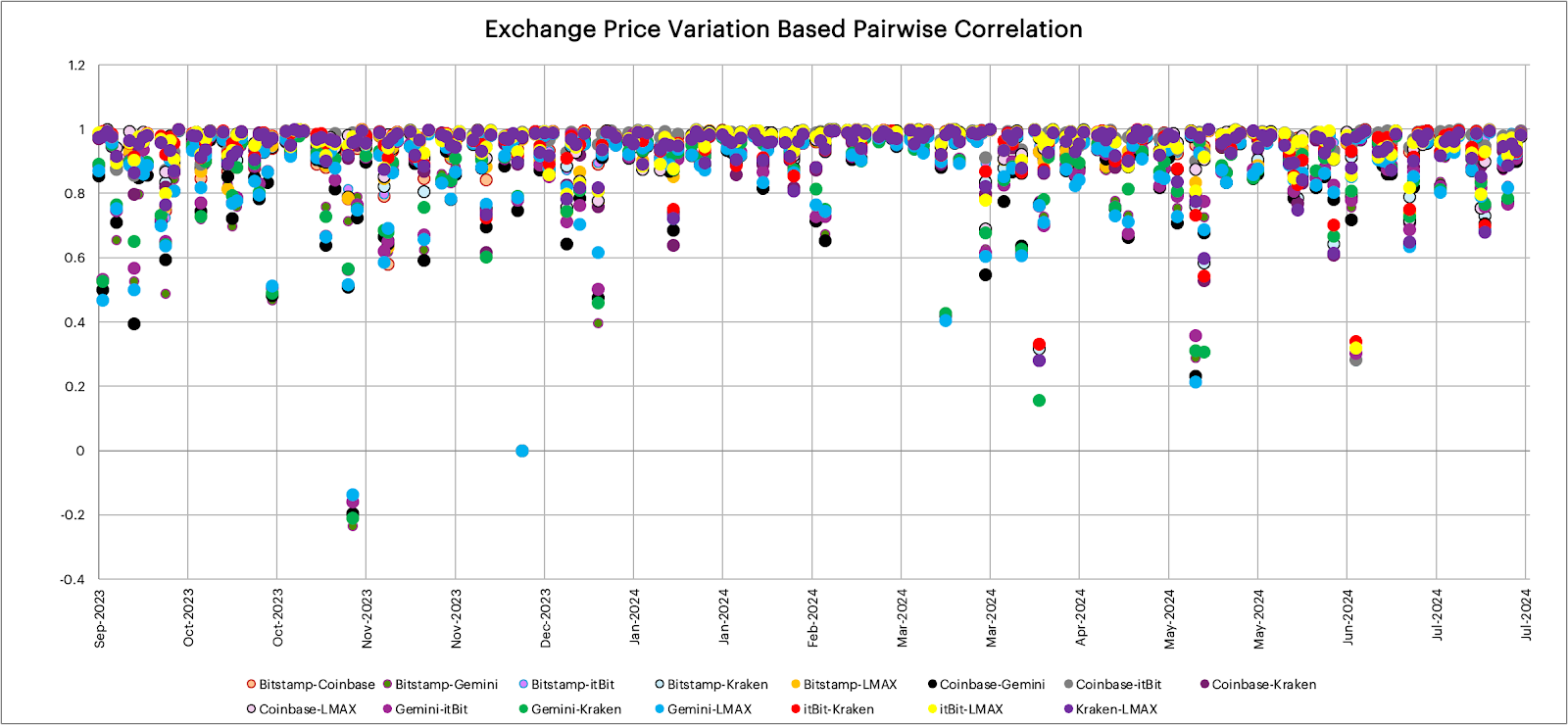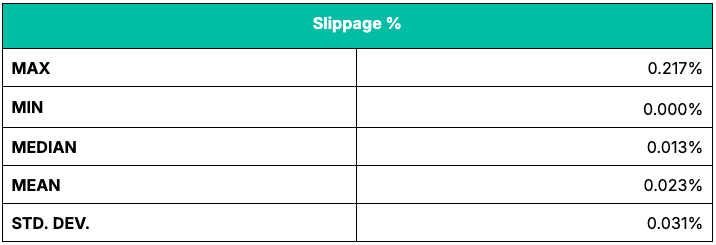Sep 13, 2024
Suitability Analysis of the CME CF Ether-Dollar Reference Rate - Asia Pacific Variant as a Basis for Regulated Financial Products
Benchmarking the Price of Ether
In traditional markets, price benchmarks are used extensively for a variety of purposes, from settling derivatives transactions, to determining Net Asset Value (NAV) for investment funds, amongst a host of use cases in institutional finance. One could almost go as far as saying that the preponderance of the use of benchmarks is a hallmark of the degree to which any market is institutional in nature. Certainly, as asset classes like commodities historically saw greater participation from financial institutions, benchmarks such as the S&P GSCI became more ubiquitous in that market.
The market for Ether trading has, since its inception in 2015, largely been driven by individual investors, with institutional participation rising since 2021, when the first regulated Ether futures contracts were launched by CME Group. A major inflection point for Ethereum occurred in 2024, when many regulatory concerns in relation to market manipulation, custody and price volatility, were overcome. Ethereum ETFs were subsequently approved in APAC and the US in April and July 2024.
Whilst Ether is, like Bitcoin, a novel asset, the requirements of a benchmark price for Ether are no different from those required of a benchmark price for any other asset. Whether it be Brent/WTI for crude oil, Term SOFR for money markets, or EuroStoxx 50 for the European equity markets, any benchmark needs to be representative of the underlying market, resistant to manipulation, and replicable by market participants, in order to foster further institutional participation in the underlying market it measures.
The first step to take towards assessing whether a benchmark price is possessed of those qualities is to understand why the price of any asset, asset class, or financial product requires a benchmark. In the case of ETFs, the primary purpose of a benchmark is to determine the cash value of the investments held by the ETF so that the Net Asset Value (NAV) of its holdings can be calculated.
In turn, this facilitates a number of processes that are crucial to the operation of an ETF and serve its investors.
- Shares are created and redeemed at NAV. A consistent and reliable NAV strike across time allows Authorized Participants (APs) to provide reliable secondary market liquidity, resulting in tight spreads for investors that buy or sell the shares.
- Efficacy of the ETF structure and operational skill of the ETF manager are measured. When a benchmark is suitable for the purpose of striking NAV for an ETF, then the ETF should track the benchmark price closely. If tracking error becomes evident, then it is symptomatic of either poor structure (i.e., a poor choice of benchmark) or a deficiency in the skills of the manager.
As such, for an ETF benchmark to fulfill the above two objectives, it must first achieve the 'three Rs' mentioned above; be representative of the underlying market, be resistant to manipulation and be replicable by market participants; especially APs, given the role they play in providing liquidity and their need to create and redeem ETF shares.
The CME CF Ether-Dollar Reference Rate – Asia Pacific Variant
This paper seeks to understand whether those qualities are being achieved by the regulated CME CF Ether-Dollar Reference Rate – Asia Pacific Variant (ETHUSD_AP).
The purpose of the CME CF Ether-Dollar Reference Rate – Asia Pacific Variant is to provide a replicable, manipulation-resistant and representative Ether benchmark that synchronizes with the traditional APAC market close. ETHUSD_AP is a once-a-day benchmark index price for Ether denominated in U.S. dollars. Input data are obtained from major cryptocurrency exchanges that conform to the CME CF Constituent Exchange Criteria.
The ETHUSD_AP index has been calculated every day since its launch on September 11th, 2023. It is methodologically identical to the regulated CME CF Ether-Dollar Reference Rate (ETHUSD_RR) that has been calculated daily since its launch on 14th May 2018; except that ETHUSD_RR references the daily price of Ether at 16:00 London Time, whilst ETHUSD_AP references the price of Ether at 16:00 Hong Kong Time.
All three CF Benchmarks Reference Rates, ETHUSD_RR; ETHUSD_NY and ETHUSD_AP, are regulated Benchmarks under the UK Benchmarks Regulation (BMR) regime. ETHUSD_AP serves as the NAV for exchange listed investment products from Harvest Global Investments, Bosera Funds/Hashkey Capital and China AMC.
Calculation Methodology
The ETHUSD_AP calculation methodology aggregates transactions of Ether in U.S. dollars conducted only on the most liquid markets for which data are publicly available, and operated by exchanges that meet the CME CF Constituent Exchange Criteria.
The list of Constituent Exchanges and information about changes to its composition are available at the following URL:
The full methodology is available here:
CME CF Reference Rate Methodology
The methodology can be summarized thus:
- Transactions conducted on Constituent Exchanges are observed during a one-hour window from 15:00 to 16:00 Hong Kong Time
- The one-hour window is divided into 12 partitions of equal length (five minutes each)
- For each partition, a volume-weighted median (VWM) is calculated
- The index value is expressed as the arithmetic mean of the 12 VWMs calculated in the previous step
Benchmark validity and volume sufficiency
A valid and robust benchmark needs to be calculated from input data of sufficient volume so that it is representative of the market it seeks to measure. From a practical perspective, volume sufficiency is also key in order for the benchmark to be replicated by institutional market participants and product providers.
To begin demonstrating how ETHUSD_AP measures up, data summarizing total transactions at ETHUSD_AP observed each month between September 2023 and July 2024, and the average number of transactions per day (weekdays only), during a daily observation window of 15:00 to 16:00 Hong Kong Time, are presented in Figure 1. Note the data represent both trade count and Ether volume.
Figure 1

Between September 11th, 2023, and July 31st, 2024, 5,326 Ether, or $14.6 million were traded, on average, during each daily observation window. Whilst Ether trading activity typically exhibits volatility, this volatility is not substantially different from that shown by traditional asset markets. In conclusion, the volume observed at ETHUSD_AP and the reliability of that volume are clearly evident to be sufficient for the calculation of a robust and reliable benchmark.
Resistance to Manipulation – Benchmark Integrity
This section will address the question of whether ETHUSD_AP is possessed of integrity in the specific sense applied by securities regulations. The practical imperative is that a benchmark requires integrity because it will be used for a wide range of activities such as asset valuation, settlement of financial risk, risk management, NAV calculation, unit creation and unit redemption. Specifically, the benchmark must both be shown to be free of manipulation, and be administered and calculated in a manner that deters and impedes manipulation.
Deterring and Impeding Manipulation
The methodological design underlying ETHUSD_AP and its system of administration incorporate measures that promote integrity as outlined in the sub-sections below.
Impeding Manipulation by Input Data selection
CF Benchmarks sources input data exclusively from Constituent Exchanges that meet published criteria as set out in its Constituent Exchanges Criteria. The criteria are available at this link:
CME CF Constituent Exchange Criteria
Particular attention is drawn to the following statement from the Constituent Exchanges Criteria document (part 2 of Section 3, page 5: ‘Eligibility Criteria’):
“The venue has policies to ensure fair and transparent market conditions at all times and has processes in place to identify and impede illegal, unfair or manipulative trading practices.”
CF Benchmarks ascertains the presence of fair and transparent market conditions and processes to identify and impede illegal, unfair or manipulative practices by conducting a thorough review of any exchange under consideration for inclusion as a Constituent Exchange. The arrangements of all Constituent Exchanges are reviewed annually to ensure they continue to meet all specified criteria. This due diligence is documented, and the information is distributed to CF Benchmarks’ oversight organs to consider. The deliberations of oversight organs are conducted during regular meetings. Minutes of such meetings are published by the Administrator on its website.
Manipulation resistance by design
Resistance to manipulation is a priority aim of the design methodology underlying the CME CF Ether-Dollar Reference Rate – Asia Pacific Variant. The methodology takes an observation period and divides it into equal partitions of time. The volume-weighted median of all transactions within each partition is then calculated. The benchmark index value is determined from the arithmetic mean of the volume-weighted medians, equally weighted. The benefits of this process with respect to achieving manipulation resistance are outlined below.
- Use of partitions
Individual trades of large size have limited effect on the index level as they only influence the level of the volume-weighted median for that specific partition.
A cluster of trades in a short period of time will only influence the volume-weighted median of the partition or partitions they were conducted in.
- Use of volume-weighted medians
Use of volume-weighted medians as opposed to volume-weighted means ensures that transactions conducted at outlying prices do not have an undue effect on the value of a specific partition.
- Equal weighting of partitions
By not volume weighting partitions, trades of large size or clusters of trades over a short period of time will not have an undue influence on the index level.
- Equal weighting of constituent exchanges
CF Benchmarks applies equal weight to transactions observed from CME CF Constituent Exchanges. With no pre-set weights, potential manipulators cannot conduct manipulative trades by targeting one platform.
- Use of arithmetic mean of partitions
Use of the arithmetic mean of partitions of equal weight further prevents the effect of trades of large size at prices that deviate from the prevailing price from having undue influence on the benchmark level.
Manipulation resistance by exclusion of input data
A specific procedure for dealing with potentially erroneous data is incorporated into the methodology of ETHUSD_AP. Although volume-weighted medians of transaction prices from individual data sources are not part of the benchmark determination process, they are calculated as a means of quality control and manipulation resistance.
In the event of an instance of index calculation in which a Constituent Exchange’s volume-weighted median transaction price exhibits an absolute percentage deviation from the volume-weighted median price of other Constituent Exchange transactions that is greater than the Potentially Erroneous Data Parameter (PED), then transactions from that Constituent Exchange are deemed potentially erroneous and excluded from the index calculation. For ETHUSD_AP, the PED was set at 10% at the inception of the index on September 11th, 2023. The PED was then reduced to 5% on June 11th, 2024. It has remained at that percentage to date. All instances of data excluded from a calculation trigger a Benchmark Surveillance Alert that is investigated.
Between September 11th, 2023, and July 31st, 2024, the Potentially Erroneous Data Parameter of the methodology for the CME CF Ether-Dollar Reference Rate – Asia Pacific Variant was not triggered.
Analysis of the maximum volume-weighted median per exchange during the observation period produced the results in Table 1. These results illustrate that it was not necessary to exclude any Constituent Exchange’s input data during the observation period due to the demonstration of potential manipulation. Indeed, the data indicate that no individual cryptocurrency exchange exhibited a deviation percentage above 0.97% during this period.
Table 1

Benchmark Surveillance
Although a series of measures have been undertaken to mitigate the risk of benchmark manipulation, CF Benchmarks remains vigilant against attempted benchmark manipulation and monitors input data continuously. To that end, CF Benchmarks has implemented a benchmark surveillance programme for the investigation of alerts. Instances of suspected benchmark manipulation are escalated through appropriate regulatory channels in accordance with CF Benchmarks’ obligations under the UK Benchmarks Regulation (UK BMR). Regarding benchmark manipulation, Article 14 of the UK BMR, Reporting of Infringements, states:
"1. An administrator shall establish adequate systems and effective controls to ensure the integrity of input data in order to be able to identify and report to the FCA any conduct that may involve manipulation or attempted manipulation of a benchmark, under Regulation (EU) Number 596/2014.
2. An administrator shall monitor input data and contributors in order to be able to notify the FCA and provide all relevant information where the administrator suspects that, in relation to a benchmark, any conduct has taken place that may involve manipulation or attempted manipulation of the benchmark, under Regulation (EU) Number 596/2014, including collusion to do so."
As a regulated Benchmark Administrator, CF Benchmarks is subject to supervision by the UK FCA. Furthermore, CF Benchmarks’ Control Procedures with respect to compliance with the UK BMR have been audited by ‘Big Four’ accountancy firm Deloitte. The Independent Assurance Report on Control Procedures Noted by CF Benchmarks Regarding Compliance with the UK Benchmarks Regulation as of 12 September 2022 is available at the following link:
CF Benchmarks SOC1 Audit Report by Deloitte
This further verification of CF Benchmarks’ compliance with the UK BMR places the CME CF Ether-Dollar Reference Rate – Asia Pacific Variant on the same level of scrutiny applied to widely used traditional financial benchmarks like ICE SWAP, SONIA and RONIA.
Assessing ETHUSD_AP values and input data for signs of manipulation
Whilst ETHUSD_AP was designed and is administered to the highest standards, including efforts to uphold provisions of the UK BMR, the proof of the pudding is in the eating, and further analysis of the data is required to evaluate their efficacy against the 'three Rs'.
Were there to be a lack of integrity in the input data that could, in turn, affect the integrity of the benchmark, one would expect to see one of a number of phenomena reflected in the input data provided by Constituent Exchanges. One potential example would be significant price dislocations between Constituent Exchanges.
How well correlated are Constituent Exchange prices?
An analysis was undertaken of the pair-wise correlation of prices from Constituent Exchanges on a per-minute basis (the price difference between transactions for each minute at each exchange) during the observation period. The results of this analysis are shown in Table 2.
Table 2

To illustrate the data analyzed in Table 2 in graphical form, Figure 2 (below) displays the full data set. The clustering of correlation coefficients towards 1.00 and the fact that on only around 3% of days did any exchange have a correlation with another exchange below 0.5, demonstrate strong price correlation between the Constituent Exchanges and point towards fair and orderly markets.
Figure 2

Replicability and Implementation
The final characteristic of the ETHUSD_AP that this paper will examine with respect to its merits as a benchmark price is its replicability. In other words, that the ETHUSD_AP benchmark price can be transacted in practice on any given day without undue risks.
Buying and selling large amounts of Ether at ETHUSD_AP
To begin demonstrating the replicability—or to use another term, the achievability—of the strategy presented in this paper for purchasing Ether ‘at scale’, observations taken whilst modeling the purchase or sale of a notional large amount of Ether are presented below. It was decided that the purchase or sale of 540.58.18 Ether (c. $1.5M at the time of writing) was at an adequate scale to represent a large Ether trade of the kind that institutional traders might need to undertake for a client, or that an issuer of a financial product (such as an ETF, or a derivative) would be required to execute on any given day, in order to facilitate trading of that product. A simple replication simulation was thereby conducted to demonstrate the extent of slippage that implementation of ETHUSD_AP would probably encounter. Given that the purpose was to demonstrate institutionally sized liquidity, the simulation was conducted on weekdays only.
Simulation Methodology
- Trades are executed on n (6) Constituent Exchanges, during a 3,600-second window
- One trade is executed every second and the price achieved is assumed to be the last execution price observed in that second. Its associated volume is assumed to be the volume executed during that second
- If no trade is completed in any single-second period, then the price achieved is assumed to be the price achieved in the previous second, but the associated volume from the previous second is not added to the volume executed in the latest second
It is worth noting that in the ‘real world’, institutions deploy algorithmic systems to execute large-scale asset purchases. It is highly probable that conducting the exercise presented here by means of algorithmic systems would have produced outcomes that are even more favorable. For research purposes, a simplified simulation methodology was favored to demonstrate the replicability of ETHUSD_AP.
The results of this exercise are displayed in Figure 3 and summary data provided in Table 3. As can be seen, ETHUSD_AP can be replicated with a high degree of confidence, and usually with slippage of no more than 2 basis points (bps). On only 8.58% of days would slippage have been greater than 5 bps. Indeed, even on the most volatile day, slippage was only 21.7 basis points. Furthermore, in the 11-month period under observation, slippage would have been in double-digit basis points only 9 times.
Table 3

Figure 3

Conclusion
From the analysis conducted, it is quite clear that the CME CF Ether-Dollar Reference Rate – Asia Pacific Variant exhibits all the key properties required of a benchmark.
Representative: Ether-USD markets that are operated by the CME CF Constituent Exchanges during 15:00 to 16:00 Hong Kong Time are liquid, with sufficient volume of trading to represent the market in a robust manner.
Resistant to Manipulation: The ETHUSD_AP Constituent Exchange Criteria ensure that it takes input data only from cryptocurrency exchanges that exhibit fair and orderly behavior, where trading shows strong price correlations between each exchange. On top of this, the methodology employed by ETHUSD_AP nullifies the effects of any manipulation, and the Administrator’s policies and processes regarding surveillance ensure that any manipulation is detected.
Replicable: The ETHUSD_AP methodology promotes replicability, allowing users, including Authorized Participants of ETFs, to replicate the benchmark simply, and without undue risk. That in turn furnishes APs with the confidence required to provide secondary market liquidity to ETF shares.
For a suitability analysis of the CME CF Ether-Dollar Reference Rate - New York Variant (ETHUSD_NY), please click the link below.
Suitability Analysis: CME CF Ether-Dollar Reference Rate - New York Variant (ETHUSD_NY)
The information contained within is for educational and informational purposes ONLY. It is not intended nor should it be considered an invitation or inducement to buy or sell any of the underlying instruments cited including but not limited to cryptoassets, financial instruments or any instruments that reference any index provided by CF Benchmarks Ltd. This communication is not intended to persuade or incite you to buy or sell security or securities noted within. Any commentary provided is the opinion of the author and should not be considered a personalised recommendation. Please contact your financial adviser or professional before making an investment decision.
Note: Some of the underlying instruments cited within this material may be restricted to certain customer categories in certain jurisdictions.
CF Benchmarks Newsletter Issue 97
Crypto prices might be locking into a nervous range, but a new arena of speculation - prediction markets - led by Kalshi, looks unstoppable. Meanwhile, digital asset ETF launches are accelerating.

Ken Odeluga
Kalshi Leads Surging Crypto Event Contract Market, Powered by CF Benchmarks
An exploration of the nature and scope of the crypto prediction market opportunity within the domain of U.S. regulations - where Kalshi is the dominant player.

Ken Odeluga
Re-admission of Kiln as a CF Constituent Staking Provider for the CF ETH Staking Reward Rate Index and related indices
Following a review, the Administrator is satisfied that the performance of Kiln’s Ethereum validators was not compromised by a vulnerability incident impacting a third party in September.

CF Benchmarks